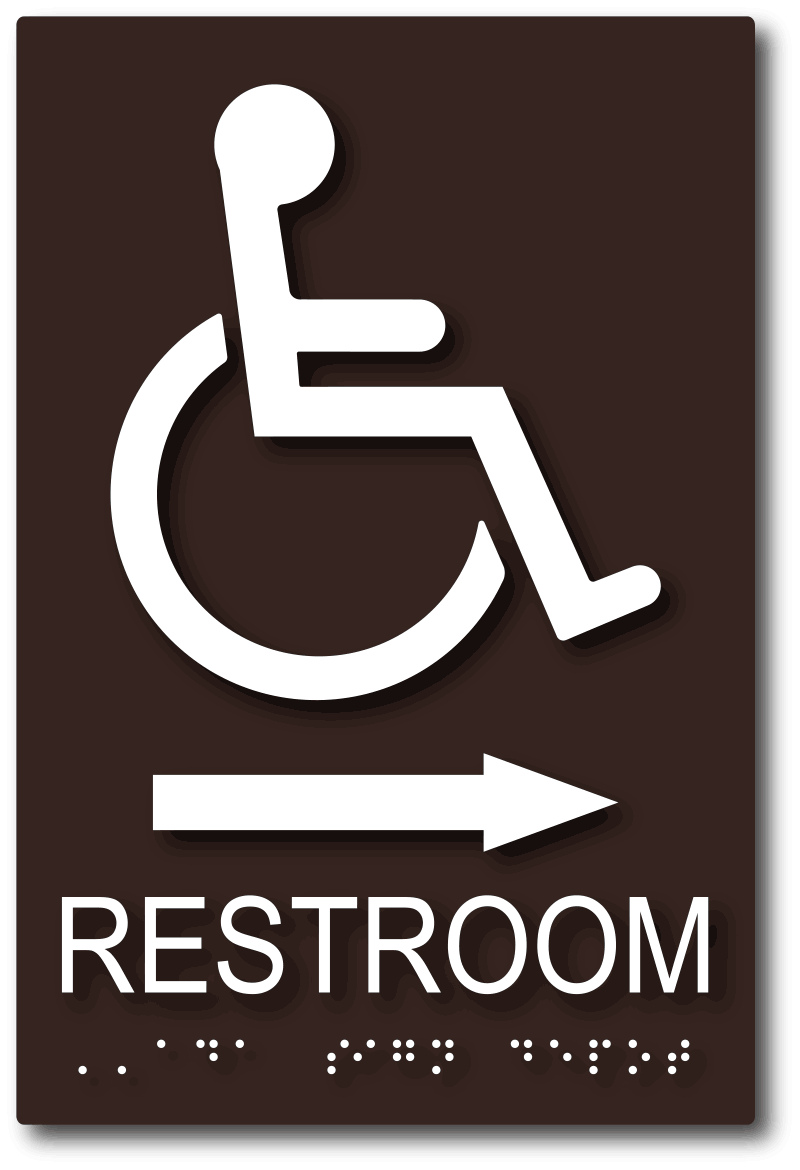Discovering the Trick Attributes of ADA Indicators for Boosted Access
In the world of ease of access, ADA indications serve as quiet yet powerful allies, making sure that spaces are inclusive and accessible for individuals with disabilities. By integrating Braille and tactile elements, these signs damage obstacles for the aesthetically impaired, while high-contrast shade schemes and clear fonts cater to diverse aesthetic needs.
Relevance of ADA Compliance
Ensuring conformity with the Americans with Disabilities Act (ADA) is vital for fostering inclusivity and equal access in public rooms and work environments. The ADA, established in 1990, mandates that all public centers, employers, and transportation solutions fit people with handicaps, guaranteeing they enjoy the exact same civil liberties and opportunities as others. Compliance with ADA standards not only fulfills lawful commitments yet additionally boosts an organization's credibility by showing its commitment to variety and inclusivity.
One of the vital aspects of ADA conformity is the implementation of easily accessible signs. ADA signs are designed to guarantee that people with handicaps can easily browse with structures and spaces.
Additionally, adhering to ADA policies can minimize the threat of lawful effects and potential fines. Organizations that fail to comply with ADA guidelines may encounter penalties or claims, which can be both harmful and financially challenging to their public picture. Hence, ADA conformity is integral to cultivating an equitable atmosphere for every person.
Braille and Tactile Elements
The consolidation of Braille and responsive components right into ADA signs embodies the principles of ease of access and inclusivity. These attributes are vital for individuals who are blind or aesthetically damaged, enabling them to navigate public rooms with greater freedom and self-confidence. Braille, a tactile writing system, is vital in supplying created details in a layout that can be easily regarded through touch. It is typically positioned beneath the equivalent message on signage to ensure that individuals can access the details without aesthetic aid.
Tactile elements extend past Braille and consist of elevated personalities and icons. These elements are developed to be discernible by touch, allowing individuals to identify area numbers, restrooms, exits, and various other critical areas. The ADA establishes details standards pertaining to the dimension, spacing, and positioning of these responsive aspects to enhance readability and make sure consistency throughout various settings.

High-Contrast Color Pattern
High-contrast color design play a critical role in boosting the visibility and readability of ADA signs for individuals with aesthetic disabilities. These schemes are crucial as they maximize the distinction in light reflectance between message and background, making certain that indications are easily noticeable, also from a distance. The Americans with Disabilities Act (ADA) mandates the use of details shade contrasts to fit those with minimal vision, making it an important aspect of conformity.
The efficacy of high-contrast shades depends on their capability to stand out in different lights conditions, consisting of dimly lit atmospheres and locations with glare. Normally, dark text on a light background or light message on a dark history is utilized to attain ideal comparison. Black message on a white or yellow background supplies a raw visual difference that helps in fast acknowledgment and comprehension.

Legible Fonts and Text Dimension
When taking into consideration the layout of ADA signage, the choice of clear font styles and ideal text size can not be overstated. These components are crucial for guaranteeing that indications are accessible to individuals with visual problems. The Americans with Disabilities Act (ADA) mandates that fonts need to be not italic and sans-serif, oblique, script, extremely attractive, or of unusual type. These demands aid make sure that the message is easily readable from a range which the personalities are distinct to varied target markets.
According to ADA guidelines, the minimal text elevation ought to be 5/8 inch, and it should raise proportionally with seeing range. Consistency in message size adds to a cohesive aesthetic experience, aiding people in navigating settings efficiently.
In addition, spacing between lines and letters is important to legibility. Appropriate spacing avoids characters from appearing crowded, boosting readability. By sticking to these standards, developers can considerably boost availability, guaranteeing that signs serves its desired purpose for all people, despite their visual abilities.
Reliable Placement Methods
Strategic positioning of ADA signs is necessary for making best use of accessibility and ensuring conformity with lawful requirements. ADA guidelines stipulate that signs need to be placed at an elevation between 48 to 60 inches from the ground to ensure they are within the line of view for both standing and seated people.
Furthermore, indications must be positioned adjacent to the lock side of doors to enable very easy recognition before access. Consistency in sign positioning throughout a center improves predictability, lowering complication and boosting overall individual experience.

Final Thought
ADA indications play an important function in promoting Full Report ease of access by integrating features that address the needs of individuals with disabilities. These elements collectively foster an inclusive atmosphere, highlighting the significance of ADA compliance in guaranteeing equal accessibility for all.
In the world of availability, ADA indications serve as quiet yet effective allies, making sure that areas are navigable and comprehensive for individuals with disabilities. The ADA, passed in 1990, mandates that all public centers, employers, and transportation solutions fit individuals with handicaps, guaranteeing they take pleasure in the same rights and possibilities as others. ADA Signs. ADA indications are developed to make certain that people with impairments can conveniently browse through structures and areas. ADA guidelines specify that indicators need to be installed at a height between 48 to 60 inches from the ground to ensure they are within the line of view for both standing and seated individuals.ADA indications play an important duty in advertising availability by integrating attributes that deal with the demands of great post to read individuals with handicaps
Comments on “The Duty of ADA Signs in Following Access Standards”